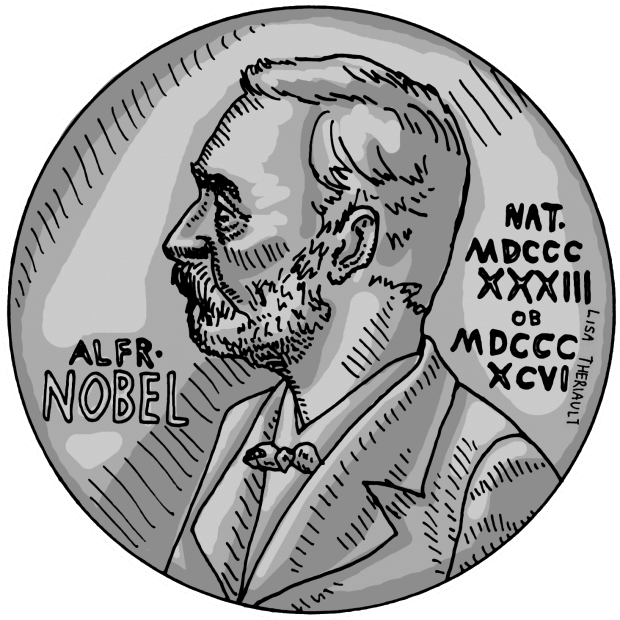 Honours awarded for chemistry, physics, and physiology.
Honours awarded for chemistry, physics, and physiology.
The Nobel Prize in honour of scientific advances considered the greatest advances of the past year. On October 8, 9, and 10 the recipients for the physics, chemistry, and medical awards were respectively announced.
François Englert and Peter W. Higgs were awarded the 2013 Nobel Prize in Physics for their proposed theory for how particles acquire mass. While they both proposed the theory separately in 1964, they were only proven correct by the discovery of the Higgs boson particle by CERN’s Large Hadron Collider (LHC) in 2012.
The standard model of particle physics states that everything is made from a few building blocks, matter particles, and are governed by forces mediated by force particles.
A key portion of this model is the Higgs field that was proposed to fill up all of space, giving mass to the other particles in the Standard Model (electrons, neutrons, and quarks). The Higgs boson particle is an excitation in this everywhere-permeating field and is in turn needed in the Standard Model to explain the weak nuclear force, as well as why any of the other particles have mass at all. The boson is the only part of the Higgs field that is independently verifiable due to the fact that the other parts are tangled within the weak nuclear force and give particles mass. This was confirmed by experimental data consistent with theoretical predictions.
While this discovery helps to confirm the Standard Model, and is a milestone for particle physics, it is far from being the final solution as the Standard Model cannot explain parts of the greater cosmic puzzle. CERN and the scientists working on the LHC hope to further this experimental exploration in years to come.
The Nobel Laureates in Chemistry were computational chemists Martin Karplus, Michael Levitt, and Arieh Warshel, who laid the foundation for the programs that are used to understand and predict chemical processes.
Classical chemistry cannot experimentally map every step in a chemical process due to the speed with which the reactions take place. Using computers, Karplus, Levitt, and Warshel created methods that allowed for the use of both classical and quantum physics, and therefore chemistry, within the computational field. Karplus began by developing computer programs that used quantum chemistry to simulate chemical reactions, and then collaborated with the programs developed by Levitt and Warshel that were based on the classical theories. The resultant programs allowed for the simulations to draw on the requisite model for different purposes—quantum for the calculation of free electrons, and classical for all other electrons and atomic nuclei. This initial program only allowed for the simulation of molecules with mirror symmetry, but further work by the three scientists produced a computerized model for enzymatic reactions that could be used for any molecule of any size.
These programs allow for a further universal understanding of how chemical processes occur, with applications ranging from examination of life molecules to drugs and chemical industrial processes. By utilizing the computer power to perform calculations of large chemical systems, the Laureates have enabled the advancement of chemistry far beyond the bounds of experimental determination.
The Nobel Prize in Medicine/Physiology was awarded to three scientists—James Rothman, Randy Schekman, and Thomas Südhof—for the determination of how cells organize their transport system though discovery of the molecular principles that govern delivery of vesicles.
Vesicles are miniature membrane shuttles that move essential molecules such as hormones, neurotransmitters, and enzymes into, out of, and around the cell. Schekman was responsible for determination of the set of genes that were required for vesicle traffic that act as genetic controllers that mediate transport within the cell. Rothman’s discovery was also related to the organization of the cell transport system, focusing on the protein machinery that allows vesicles to fuse with their targets to permit the transfer of the contained molecules. He was responsible for the discovery of the protein complexes that enable vesicles to fuse with the target membrane at a specific location. The third discovery, by Südhof, was the identification of the molecular machinery that responds to ion influx to signal the binding and release of the vesicle and its cargo at the specific binding site. This third portion of the discovery explains how temporal precision and content release on command is achieved.
These discoveries are key to the fundamental processes of cell physiology, and have a major impact on the understanding of how vesicle transport and fusion operate; critical to processes such as neuron signalling and hormone release. Without these newly discovered processes, cell organization would not be effective and the cellular communication would be impossible.





